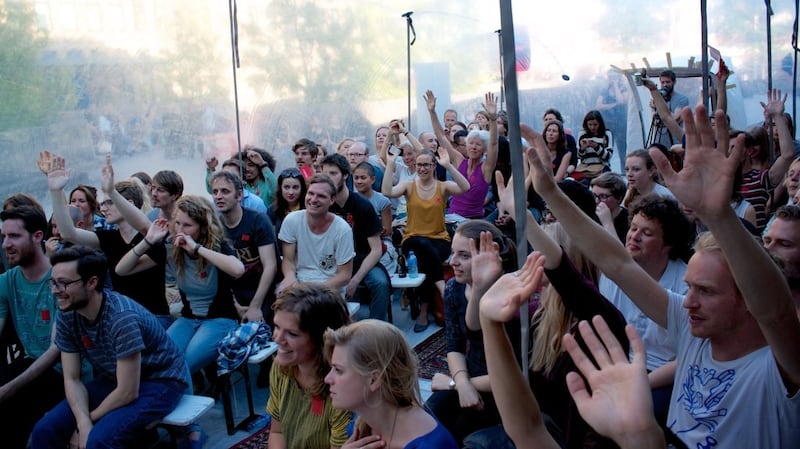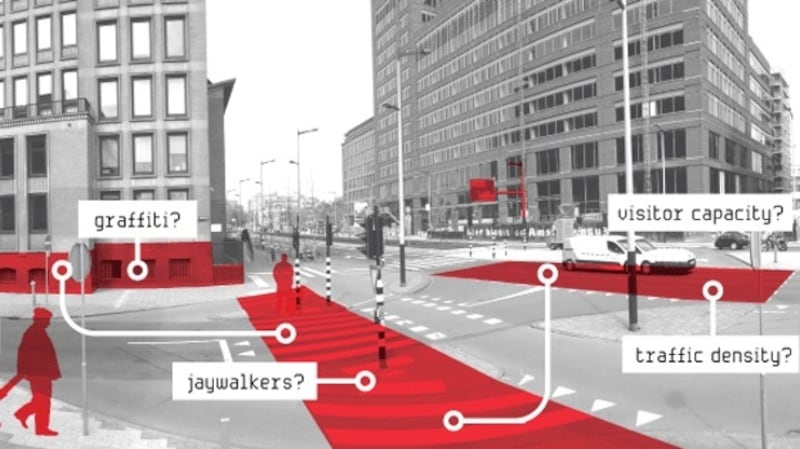Think of picturesque old Amsterdam with its gingerbread houses and bockety bridges – and it’s nothing at all like the long straight concrete corridor from Amstelplein to Nieuwmarkt, a soulless stretch of rundown office blocks, heavy traffic, dodgy air quality and a definite whiff of urban decay.
Welcome to The Knowledge Mile, a groundbreaking multi-tiered planning initiative aimed at transforming a rundown quarter with “a high concentration of social challenges” into “the smartest street in the Netherlands” – a 21st century connected neighbourhood, “green” in every sense.
By 2025, this “living lab” should be the go-to location for city planners and conservationists from all over the world, demonstrating how creative use of the latest technology can allow a remarkable digital “dialogue” between a place and its occupants, and a new and sustainable future for both.
What’s unique about The Knowledge Mile – and what’s powered its success – is that it’s happened organically. Nobody set out to find the perfect stretch of no-man’s land to test what cutting-edge data collection can tell us about where we live and how to visualise complex urban change.
It was more a case of necessity being the mother of invention: unlovely Wibautstraat and Weesperstraat and the area immediately around them are all we’ve got, the thinking went – we simply must have the tools and the know-how to do better than this. The good news is that they did.
The greatest stroke of luck, in fact, for this forgotten corner of an otherwise teeming capital was that it’s home to a world-class cluster of Amsterdam university campuses with more than 60,000 students and staff, many of whom also live locally and are active in the 30,000-strong community.
In a sense, that was a double-edged sword: the fact that so much of the area was made up of university buildings meant it was largely abandoned at night and during holiday time and, given the realities of funding, wasn’t maintained to the highest standards. So it wasn’t exactly Bond Street.
Circle economy
On the other hand, it also meant that the project had barely been talked about over coffee before boffins of every stripe were offering to lend their services: from environmentalists to horticulturalists to IT specialists to experts in design, mobility planning and even the circle economy.
"It's hard to believe now, but this whole project started very small", recalls Joyce Overklift Vaupel Kleyn of Amsterdam Creative Industries Network, set up specifically to support collaborations of this sort between the universities of applied sciences, in particular, and local industry and society.

These collaborations are typically based on what are considered to be urgent issues in the Amsterdam metropolitan region because, that way, the universities can strengthen the interaction between the theory students learn and practice-orientated research.
“The Knowledge Mile really captured people’s imagination,” Kleyn told The Irish Times. “They knew where they were living and working wasn’t good enough. They could immediately see the possibilities. And it ballooned, really without any great structured input at first.”
Among the first co-ordinated projects was data collection, to establish what information was freely available in the immediate environment – the low-hanging fruit that was ignored in the past because there was no quick or cost-effective way of collecting or collating it.
Outside of office hours, volunteer researchers, largely students and university staff, but also employees of local businesses and local residents as well, were sent out into the streets and given things to count – using digital counters that sent their findings back to headquarters instantly.
This in itself was clever because “crowd-sourcing” their researchers meant they didn’t have to go to the expense of using hi-tech sensors.
It also gave volunteers first-hand experience of what was around pretty much every corner, which both motivated and dismayed them. Not for nothing was Wibautstraat, in particular, known as the ugliest street in Amsterdam.
"We generated a whole lot of open data," says Wouter Meys of the University of Applied Sciences.
Urban research
“We gave it to developers who were able to come up with visualisations of how things could change for the better, often in surprisingly simple and creative ways. We were also able to use it for broader urban research, which made it very cost-effective.”
Everything was counted: the traffic – Wibautstraat and Weesperstraat have four lanes each; public transport options; pedestrians and cyclists; water, gas, and electricity connections; businesses of various types; where people stopped for a chat or a cup of coffee. Was it brief or did they linger? If they lingered, what was it that kept them there?
Even dogs, cats, birds, and plants were logged – type, location, behaviour.
Digital connectivity, of course, was crucial and will remain so because 5G which will bring a revolution in the way the physical infrastructure connects to the Internet of Things. So, how many people were using phones or other mobile devices? How good or bad was connectivity? How do the tech specialists see it all evolving? What will it allow to happen that can’t happen now?

"It was really encouraging to see the data we collected in a single day up on screen that evening fully collated in graph form," said Dr Mettina Veenstra, an expert in media technology design. "I could see my work in relation to everyone else's. We had a new overall picture . . . a starting point."
There's always a cost to transformation, of course. Smaller projects, such as Knowledge Mile Park, which aims to turn the rooftops, balconies, terraces, building fronts, plazas, and even the central reservations of the roadways, into green and blooming spaces, are based largely on local enthusiasm combined with a degree of co-ordination.
So-called “meet-ups” in the evenings have been packed with residents of all ages – now known as “impatient city-makers” – arriving with beautifully detailed drawings to pitch their ideas to the audience in the hope of winning €2,500 in crowdfunding plus professional support for their projects.
For more substantial investment, there's the Knowledge Mile Biz (Business Investment Zone) where anyone who's a registered business stakeholder in the area is regarded as an entrepreneur and can draw up a plan to improve it, which must include a detailed breakdown of costs.
Collective change
That plan is then submitted to the local authority, which puts it to a vote of the business community. If it’s accepted – which it was by 85 per cent of 200-plus businesses in The Knowledge Mile – city hall sets up the BIZ, collects the financial contributions from the stakeholders (not including residents) and pays the money in a structured form to the Biz to do the work.
The beauty of the Biz model is that because the local authority is involved, it doesn’t duplicate municipal services, but instead supplements them – at effectively no cost to the city.
There are some, however, who are less than enthusiastic about getting any form of bureaucracy involved in collective neighbourhood change because they feel it should be based on individual energy and commitment – which they’re happy to give for free. That way, there’s no resentment about “free-riders”.
However, once the local authority is involved, charges are being levied, and an element of obligation is introduced, the “romance” of small groups generating big change can be lost, they warn. Instead of “What can I do to help?” the question risks becoming “What’s in it for me?”
The good news is that despite that danger, The Knowledge Mile has managed not to become jaded.
That's perhaps because it has stuck faithfully to the original model of a "living lab" as envisaged by its architects, Bill Mitchell, Kent Larson and Sandy Pentland, at Massachusetts Institute of Technology more than a decade ago.
Design, they argued, should no longer be something handed down, but had to become collaborative, responsive and, interestingly, “empathic”.
So The Knowledge Mile is, in effect, just what the academics ordered: a user-centred, open innovation, multidisciplinary, urban ecosystem, where the key characteristics of co-creation, exploration, experimentation and evaluation remain the driving forces they were at the start.
To that extent, perhaps those who’ve championed organic community action over municipal bureaucratisation have been right – and more in tune with the zeitgeist.
“If I had to think of one phrase that sums up The Knowledge Mile, I would say that it’s ‘interaction’,” says Joyce Kleyn. “That’s how it started. That’s what’s made it successful. That’s why it will continue to evolve in line with the needs of the people who live and work here.”











